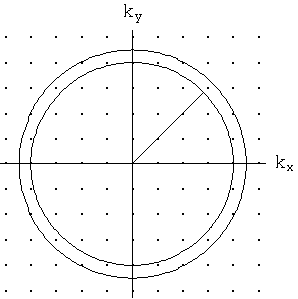|
|
Semiconductor Physics: Density of States

To calculate various optical properties such as the rate of absorption or emission and how electrons and holes distribute themselves within a solid, we need to know the number of available states per unit volume per unit energy. We first calculate the available states in k-space and then use the energy-momentum relation in parabolic bands to give the density of states in terms of energy.
By considering the electrons in a solid as a free electron gas, that is, the electrons are free to wander around the crystal without being influenced by the potential of the atomic nuclei, we can obtain a relationship for the number of available states in a solid. A free electron has a velocity v and a momentum p =m v . Its energy consists entirely of kinetic energy (V=0) therefore,
![]()
(1)
Prince Louis De-Broglie, hypothesised that if waves could exhibit particle-like properties, then might particles also exhibit wave-like properties? This idea is expressed as particle-wave duality and allows us to give the electron a wave number k .
![]()
(2)
In this way, the electron can be represented by a vector in velocity, momentum or k-space. If we choose to represent the electron state as a vector, it points in a direction given by the components magnitude of the basis vectors in k-space. It should be apparent that vectors of the same magnitude have the same energy forming spherical shells. This can be understood better, if we consider the equation for the energy of the electron in terms of k .
![]()
(3)
Classically, all values of energy would be allowed and there would be no restriction on the number of electrons with the same value of k . However, at atomic scales, the effects of quantum mechanics dominate and two further famous principles come into play. These are the Heisenburg uncertainty principle and the Pauli exclusion principle. Together, these two rules mean that the wavefunction for the electron must satisfy the Schrödinger equation, subject to boundary conditions. The solution of the Schrödinger equation leads to wavefunctions of the form:
![]()
(4)
As we consider the density of states, the situation is complicated by energy degeneracy. That is, that for some of the allowed energy levels, there are more than one possible combination of components in k-space that well give the same energy. In a quantum well, there is only one restricted energy level, therefore, the degeneracy is always 1 (not taking into account the electron intrinsic angular momentum spin). In a quantum wire, the degeneracy depends on the values of two sets of energy levels. While for a quantum dot there are three sets of discrete energy levels. This is only valid if and only if,
![]()
(5)
where n x , n y , n z are integers.
With this restriction in k-space, only certain values of k-space lead to acceptable electron wave-functions solutions. k-space would be filled if each position was filled with a cubic unit cell of volume. Explicitly, the volume of k-space would be:
![]()
(6)

Figure 1 Visualisation of k-space showing values of k as points. The number of allowed states is the number of these points contained in the shell of radius k and thickness dk.
The diagram shows the spherical shells. The problem of finding the number of allowed states amounts to finding the number of these allowed states between spheres of radius k and k +d k . In 3-dimensions, the volume between the two shells is given by:
![]()
(7)
Therefore, the number of states is given simply by dividing this volume by the volume of a single energy state. At this point is convenient to introduce an additional factor of two to account for the intrinsic angular momentum of the electrons or spin states. The result is:

(8)
To obtain the density of states per unit volume in terms of the energy we must find a relation between E and k .
![]()
(9)
rearranging gives:
![]()
(10)
and then we differentiate this with respect to the energy.

(11)
Taking the bulk case as an example, the density of states in terms of energy is then

(12)
This gives the density of states per unit volume per at a wave vector-k. It is more usual to see the density of states quoted per unit energy. We shall come back to this after looking at the density of states for 2,1 and 0 dimensional structures.
2-D Density of States
In two dimensionsal structures such as the quantum well, the procedure is much the same but this time one of the k-space components is fixed. Instead of a finding the number of k-states enclosed within a sphere. The problem is to calculate the number of k-states lying in an annulus of radius k to k +d k . k-space would be completely filled if each state occupied an area of
![]()
(13)
And the 'volume' of the annulus is given by
![]()
(14)

Figure 2 k-space in 2D. The density of states at an energy E is the number of k-states per unit volume contained with the annulus of radius k and thickness dk.
Dividing the 'volume' of the k-state by the area of the annulus gives and remembering to multiply by 2 to account for the electron spin states we get:
![]()
(15)
Or in terms of energy per unit volume at an energy E .

(16)
It is significant that the 2-d density of states does not depend on energy. Immediately, as the top of the energy-gap is reached, there is a significant number of available states. Taking into account the other energy levels in the quantum well, the density of states takes on a staircase like function given by:
![]()
(17)
where H (E-Ei) is the Heaviside function. It takes the value of zero when E is less than E i and 1, when E is equal to or greater than E i . E i is the i -th energy level within the quantum well.
1-D Density of States
In one dimension two of the k-components are fixed, therefore the area of k-space becomes a length and the area of the annulus becomes a line.
![]()
(18)
![]()
(19)
Therefore the density of states per unit length in 1-d and multiplying by 2 for spin degeneracy,
![]()
(20)
For one dimension, the density of states per unit volume at energy E is given by
![]()
(21)
Using more than the first energy level, the density of states function becomes

(22)
where once again, H ( E-E i ) is the Heaviside function and n i is the degeneracy factor. For quantum structures with dimensions lower than 2, it is possible for the same energy level to occur for more than one arrangement of confined states. To account for this, a second factor n i ( E ) is introduced.
0-D Density of States
In a 0-D structure, the values of k are quantised in all directions. All the available states exist only at discrete energies described and can be represented by a delta function. In real quantum dots, however, the size distribution leads to a broadening of this line function.
Table 1. shows the number of degenerate states for the ten lowest energy levels in a quantum well (2D), quantum wire (1D) and quantum box (0D). In the quantum well, the ratio of the i th energy level to the ground state level E 0 is proportional to k 2 and in each case since there is only one way in which k can be arranged to obtain this energy, the degeneracy is of each energy level is just 1. The quantum wire has two values of k to control its energy and therefore the energy is proportional to the sum of the squares of each k value. (For example: 5=1 2 +2 2 ) and where the values of k are different there are two ways of obtaining the same ratio of energy. Therefore in this case the degeneracy is two. The quantum box is confined in all three k -directions and its energy is proportional to the sum of the squares of each k values. As one might expect, the scope for degenerate energy levels is also greater. Where the k values are all different, there are 6 ways in which the k values can be arranged to produce the same value of energy.
The table below summarises the ratio of allowed energies to ground state energy and degeneracy of the energy level for 2D, 1D and 0D structures. While the graph shows the density of states functions plotted against energy.
|
2D |
1D |
0D |
||||||
|
State |
E/E 0 |
n(E) |
E/E 0 |
Degenerate States |
n(E) |
E/E 0 |
Degenerate States |
n(E) |
|
1 |
1 |
1 |
2 |
(1,1) |
1 |
3 |
(1,1,1) |
1 |
|
2 |
4 |
1 |
5 |
(2,1),(1,2) |
2 |
6 |
(2,1,1),(1,2,1),(1,1,2) |
3 |
|
3 |
9 |
1 |
8 |
(2,2) |
1 |
9 |
(2,2,1),(1,2,2),(2,1,2) |
3 |
|
4 |
16 |
1 |
10 |
(3,1),(1,3) |
2 |
11 |
(3,1,1),(1,3,1),(1,1,3) |
3 |
|
5 |
25 |
1 |
13 |
(3,2),(2,3) |
2 |
12 |
(2,2,2) |
1 |
|
6 |
36 |
1 |
17 |
(4,1),(1,4) |
2 |
14 |
(3,2,1),(3,1,2),(2,3,1)
|
6 |
|
7 |
49 |
1 |
18 |
(3,3) |
1 |
17 |
(3,2,2),(2,3,2),(2,2,3) |
3 |
|
8 |
64 |
1 |
20 |
(4,2),(2,4) |
2 |
18 |
(4,1,1),(1,4,1),(1,1,4) |
3 |
|
9 |
81 |
1 |
25 |
(4,3),(3,4) |
2 |
21 |
(4,2,1),(4,1,2),(1,4,2)
|
6 |
|
10 |
100 |
1 |
26 |
(5,1),(1,5) |
2 |
27 |
(3,3,3) |
1 |
Table 1 Degeneracy of energy states for quantum well (2D), quantum wire (1D) and quantum box (0D).

Density of states for bulk (3D blue), quantum well (2D red), quantum wire (1D green) and quantum Dot (0D black)
References
[1] Bart Van Zeghbroeck,
Principles of Semiconductor Devices
,
Colarado University
[2] D. A. B. Miller, Semiconductor Optoelectronics Devices,
Stanford University
, (2000).
|
|